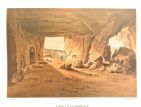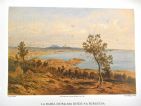
From Palma to Calvià
"We’re already familiar with the start of the Andratx road from our description of Palma’s surroundings up to the San Carlos Castle. Consequently, we’ll restart our trip from the place where the road descends towards Cala Major cove. To the left, on a height barren of any vegetation, we come to an isolated house called “des Vent”, with facades overlooking Portopí and Cala Major. The road soon turns to the right and runs between rocky and rough terrain, populated only by shrubs.
 To the left, Cala Major inlet opens up, where the road winds between hills adorned with olive and caper trees. After passing by some plaster shops, we come to a hostel called “d’En Català”, a frequent meeting point for people from Palma on pleasant excursions, stopping here to enjoy the food and drink that have made this establishment famous. After a hollow with highly stratified lime rocks, we see Bendinat Castle to the right, two paths leading up to it from the road: the first comes from Palma, taking us to the landlord’s house; the second, which comes from Andratx, takes you to the main house.
To the left, Cala Major inlet opens up, where the road winds between hills adorned with olive and caper trees. After passing by some plaster shops, we come to a hostel called “d’En Català”, a frequent meeting point for people from Palma on pleasant excursions, stopping here to enjoy the food and drink that have made this establishment famous. After a hollow with highly stratified lime rocks, we see Bendinat Castle to the right, two paths leading up to it from the road: the first comes from Palma, taking us to the landlord’s house; the second, which comes from Andratx, takes you to the main house.
From Bendinat, access is easy to the Na Burguesa range. For this, the best option is the path starting from the Andratx road, almost in front of the church in Portals, and taking it to the top of Puig de ses Creus. You go through the grove of pines overlooking the “Coma s’Arc”, so-called for the small natural arch formed there. At the top of Puig de ses Creus, which you can access with a cart and where, along with a pile of rocks which once served to hold flags or rods to take geodesic measurements, you come to a large pine tree. From this knoll you can enjoy an extensive view over Peguera Bay, Calvià Valley and the town of the same name and, in front of the latter, Es Capdellà.
 There is a pole on top of Puig Gros for a flag or signal. The peak is 485.06 m high, and the view it offers of Palma Bay, s’Esclop and Galatzó, after first crossing the nearby pine forest, is certainly beautiful.
There is a pole on top of Puig Gros for a flag or signal. The peak is 485.06 m high, and the view it offers of Palma Bay, s’Esclop and Galatzó, after first crossing the nearby pine forest, is certainly beautiful.
On Porrassa Beach, under the protection of a cape and a wall, is a small cave which fishermen use to take shelter. We climb a clay slope and come to a dip which, towards the sea, is surrounded by reddish hills and numerous maritime pines. Near these is a marsh populated by sea pinks, a marsh called the Salobrar de la Porrassa and receiving both fresh and salt water.
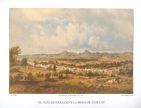 The road continues along a small valley lined by maritime pines towards the road to Calvià. A certain distance now from the pond, on a plain occupied by crops, is the house belonging to the Porrassas. It is a low but wide building with a wide clearing at its base. A fairly poor, almost unusable path starts here towards old Portals on a painful journey up the slope of Cala Figuera nearing one of the numerous valleys in this rough orography. From here, there is a beautiful and vast view of the Na Burguesa Sierra, Calvià’s mountains, Puig de Galatzó peak and the s’Esclop hill up to the heights overlooking Andratx.
The road continues along a small valley lined by maritime pines towards the road to Calvià. A certain distance now from the pond, on a plain occupied by crops, is the house belonging to the Porrassas. It is a low but wide building with a wide clearing at its base. A fairly poor, almost unusable path starts here towards old Portals on a painful journey up the slope of Cala Figuera nearing one of the numerous valleys in this rough orography. From here, there is a beautiful and vast view of the Na Burguesa Sierra, Calvià’s mountains, Puig de Galatzó peak and the s’Esclop hill up to the heights overlooking Andratx.
We begin our descent and, to the right, on the hill over Cala Figurera, a conspicuous clearing opens up amongst the pines towards the Portals cove, with its tower under siege by unkempt prickly pears. The first cave we see features two large pilasters at its entrance, representing two large doors, which duly honor the name of “Portals Cave” as it is known. Inside, there used to be an image of Mare de Déu de Portals (Mother of God of Portals), enthroned in this place due to the vow made by a Genovese merchant who had the image of the Virgin aboard his ship and was surprised in those very waters by a terrible storm.
 In Cova de Portals we can still see today the small chapel yet to be whitewashed and another two carved without further ado into the sandstone. Though dating from the Renaissance, they reminded me of Indian constructions.
In Cova de Portals we can still see today the small chapel yet to be whitewashed and another two carved without further ado into the sandstone. Though dating from the Renaissance, they reminded me of Indian constructions.
A path opening up on a slope leads from Portals to the lighthouse. Cala Figuera’s cape after the small Cala dels Bocs cove forms an outcropping which separates it from the nearby small valley called the Canal de Cala Figuera emptying there in that cove and where they once quarried stone. The first cove mentioned stands out for its numerous pine trees compared to the squalor of the second in this respect. And, if the signal tower stands out on the tallest part, the lighthouse occupies the most outward spot.
If we take the path to the left of the lighthouse along a rocky plain with a soft slope full of weeds and meager of pines, we come to Rafal, Rafalbex or Refeubeitx Tower from where there is a vast panorama of the sea and the wide Santa Ponsa inlet. In a straight line, the view from the tower goes beyond the cape to Cala de la Porrassa cove, Palma and the Serra range, all in impressive tones.
 Another pass with rocky sides ends at the Santa Ponça plain. A notable landmark here is the imposing pile of rocks gathered upon clearing the fields and with which, a bit farther on, two cabins have been built.
Another pass with rocky sides ends at the Santa Ponça plain. A notable landmark here is the imposing pile of rocks gathered upon clearing the fields and with which, a bit farther on, two cabins have been built.
Walking down, we come to the clearing with Cala de Santa Ponça in the back. The first part is a sandy shore and, later, an almost completely dry marsh, barely indicated by some tamarisks. The lagoon itself, covered in sea pinks and flanked here and there by large tamarinds and sedges, extends obliquely from the house in Santa Ponça to which there is a path.
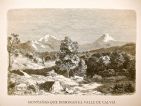 Let’s turn now to Calvià Valley to which a good road starting from the Andratx road takes us. At first, the valley is broad and flat, surrounded by forested hills. The fields, with their rounded “clapers” made of extracted rocks, seem inhabited, in general, by olive trees in addition to almond, fig and some carob trees, providing some diversity to the landscape. From a small hill is a beautiful view of Puig de Galatzó with s’Esclop as the backdrop.
Let’s turn now to Calvià Valley to which a good road starting from the Andratx road takes us. At first, the valley is broad and flat, surrounded by forested hills. The fields, with their rounded “clapers” made of extracted rocks, seem inhabited, in general, by olive trees in addition to almond, fig and some carob trees, providing some diversity to the landscape. From a small hill is a beautiful view of Puig de Galatzó with s’Esclop as the backdrop.
Calvià is a small, charming and friendly town, with 1,146 inhabitants and 228 houses, 11 of which are uninhabited. The climate is benign and has little rain, explaining why the place seems mainly dry to us. The houses are small, the majority consisting of only one story, though there are eight with two. Many have an overhanging part to shelter the beasts of burden. The town sits atop a small hill at the end of the ascending valley, surrounded by olive groves and gardens where they grow pomegranates, almond and orange trees, in addition to the ubiquitous prickly pears, thick especially around the houses. Some of these also benefit from the generous shade provided by 14 palm trees. On a small hill is the church, one of the first built after the Conquest as mentioned in a papal bull issued by Innocent IV in Lyon in 1248, listing all the churches on Mallorca and this one in particular, referring to it as Sant Joan de Calvià Church.
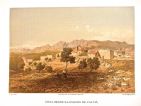 Its bell-gable rises up to 156.52 m above sea level. The church is simple, with a plain facade and two small pointed towers. It measures 28 m long by 8 high and 8 wide. Its arched interior includes five chapels on each side. This spot provides a beautiful view of the valley at its feet. There is another smaller church in Calvià, dedicated to Mare de Déu dels Dolors (Our Lady of Sorrows). It is considered a public oratory and found at the eastern end of the town. It seems to date from the 15th century, and, according to tradition, it was built to publicly venerate Mare de Déu de Portals which, despite best efforts, would disappear only reappear once more in its old cave.
Its bell-gable rises up to 156.52 m above sea level. The church is simple, with a plain facade and two small pointed towers. It measures 28 m long by 8 high and 8 wide. Its arched interior includes five chapels on each side. This spot provides a beautiful view of the valley at its feet. There is another smaller church in Calvià, dedicated to Mare de Déu dels Dolors (Our Lady of Sorrows). It is considered a public oratory and found at the eastern end of the town. It seems to date from the 15th century, and, according to tradition, it was built to publicly venerate Mare de Déu de Portals which, despite best efforts, would disappear only reappear once more in its old cave.
Calvià connects to Es Capdellà on the other side of the valley by means of a good road. To get there you have to go back on the stretch leading to the road to Palma and later turn right at some plaster shops, their exterior decorated by prickly pears and young palm trees.
A good path runs through the valley to the Possessió de Son Alfonso estate with its tower, once belonging to the Formiguera family and today to a farmer. Passing by Ses Algofres, the large Son Claret house emerges on the left, and, on the path connecting to the road between Es Capdellà and Calvià, on land still belonging to that property, on the right we come to a large olive tree with a 9-meter circumference though not many branches. Almost in front, on the opposite side, a second tree also stands out. With its almost equally impressive presence, it competes with the first tree in terms of the size of its trunk.
Es Capdellà finally welcomes us. It’s a town of only 778 inhabitants and included within the Calvià district, the latter town only 2.8 km away. It’s found on a small hill crowned by some windmills. It only has 211 dispersed houses, surrounded by prickly pears and the majority with a trailing vine at the door. Some also feature exuberant lemon trees.
The church has four side chapels, in one of which are the remains of Urban the Martyr from the catacombs in Rome. Underneath the choir are two more chapels, one serving to access the church and the other containing the baptismal font to celebrate that sacrament."
Archduke Ludwig Salvator of Austria.Las Baleares por la palabra y el grabado. Majorca: The island. Ed. Sa Nostra, Caja de Baleares. Palma de Mallorca. 1982.












